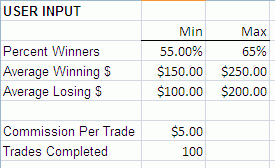In Early Stage Of System Development, Avoid Position Sizing
Many beginners in trading system development like to play with position sizing scheme. It feels great when you get a great equity curve with spectacular performance by simply twisting what position sizing rules to use and experiment with various sizing parameter settings. I have some bad news for you – such system will not likely perform in real life.
Why twisting position size is bad?
When a system in its infancy not designed around fixed position size, it will suffer the fundamental flaw of system design – curve fitting right from the beginning.
When I talked about fixed size, I mean fixed size, not fixed percent of equity, not fixed number of contracts per amount of cash on hand. For systems designed to work with stocks, you must not change the number of shares traded per position. For systems designed to work with futures, use fixed number of contracts.
When position size is fixed, you will no longer fall into the trap of believing your system is making big bucks if there is no real statistical bias in the setup.
Here is a simple example illustrating the point.
You have designed a system with an interesting entry, but, you have not figure out the matching exit method. You now apply position sizing onto the system and unaware of your twisting of position sizing rules already put you into optimizing your system around that. Your system is now curve fitted around the most profitable positions already taken by the system with position sizing rules biased around these positions. That means, when the system is used in real-time, with your real money, it will make big bets on positions that it has no idea how good the performance will be.
Worst yet, keep betting at the maximum possible size while the market characteristics has never been supporting the system entries, thus leading to huge draw down whenever you start using the system in real-time.
Designing trading system could be a good hobby. Playing with position sizing is great if trading system creation for you is just for fun. But, if your intention to creating trading system is to trade them in real-life, playing with position sizing is extremely dangerous, especially if you have not completed the signal logic of the system.
When is a good time to utilize position sizing?
Position sizing should be used, in general, after the system has proven itself in real-time trading and successfully earned the necessary money to increase the size of the position.
For future trading, that means the system has successfully earned enough real money in real trading for the account requirement based on a single contract, from the backtesting you have conducted.
For stock trading, that means the system has successfully earned enough real money for the account requirement to trade one lot. That can be the standard 100 shares lot. But for some ill-liquid stocks, that could be 1000 shares for a lot, and sometimes even more. Position sizing based on odd lots are not realistic at all. The reason is obvious, if you do not have enough money to even trade a single lot, you are not likely able to open account at brokerages that charge the very low commissions needed. Together with slippage working against you, profit from small odd lots will just vaporize in real life.
Other considerations
There are systems that need to use position sizing. That is not what a beginner should try. It does not matter how good a programmer you are or how great you trade discretionarily. If you are a beginner in system design, you must learn the basics in system trading before you can master the more complex concepts like how to scale in to a position, or, understand the maximum load a system can take (i.e. the number of contracts or shares you can trade with the system without affecting or modifying the market behaviour).
You do not need a system that is designed for million dollar hedge fund to make a living. On the other hand, systems designed for big hedge funds do not really look exactly like a system that is used by individual traders because the design consideration is very different. In between the two, there are a lot of room for many different styles of trading systems to exist and perform year after year.
Good luck in discovering your first great system!














